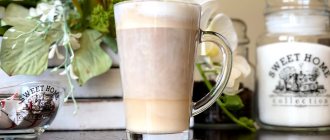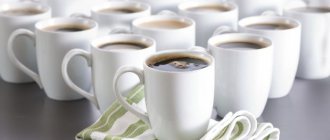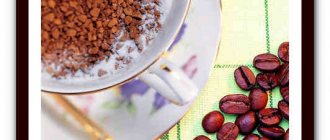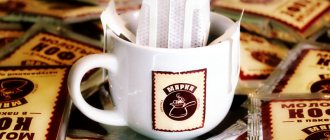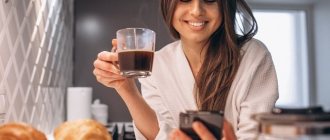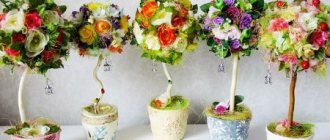Characteristics of the mug
In the classic version, it is a cylindrical vessel, complemented by a comfortable handle. You can drink cold and hot liquids from such dishes. The standard characteristics of a mug can be expanded if we consider what material it is made of and what shape it has. The volume may also vary depending on the purpose of the product.
The manufacturing material can be:
- porcelain - the cup maintains the temperature of the drink for a long time, and does not heat up at all. The material looks impressive, but it is very fragile and expensive;
- earthenware is an excellent analogue to porcelain, but the mug looks rougher - its walls are thicker. Considered ideal for home use;
- ceramics – has all the advantages of porcelain. Dishes made from such material are not very attractive, they quickly wear out and deteriorate, but they are cheap;
- glass is a modern alternative to all of the above options. The cup cools down quickly, and so does the drink itself. The vessels have an original, varied design. The price is affordable;
- glass ceramics – there are no pores in the walls of such dishes, so the products are very durable, retain heat well, and are easy to clean;
- metal: silver, stainless steel, copper, aluminum - silver mugs look elegant, but are not suitable for everyday use. Silver darkens quickly and requires careful care to maintain its shine. Copper mugs are beautiful and have an interior lining of another metal. Suitable for festive occasions or daily use. Stainless steel mugs are resistant to mechanical damage and do not require special care. A great option for every day. Aluminum products are purchased mainly as a traveling option. This mug is light in weight and can be used to boil water if necessary. The type of metal determines the cost of the product.
Glass cups are unacceptable for coffee, as the drink loses its taste and aroma. The modern material for making tableware is plastic. It is used to make camping mugs, thermal mugs, and children's dishes. Plastic products are convenient because they do not break and weigh little. Decorative cups are made of wood and stone.
Porcelain
Earthenware Glass ceramics Metal Glass Ceramics
What does volume depend on?
The volume is influenced by two main parameters - shape and purpose. The balance of characteristics is fundamental for the manufacturer and the buyer. The volume of the mug can vary from 0.03 to 1 liter. Much depends on how and where the container will be used. The standard capacity is 250 ml.
Form
The volume directly depends on the size of the mug and its shape. If the container has a standard cylinder shape, its capacity will be maximum. When the dishes have all kinds of contractions, expansions, and transitions, this parameter decreases. The larger the shape of the container, the smaller its volume.
There are 2 main shapes of a mug. The glass-shaped one has an elongated body, so at a significant height it holds little liquid. Pial-shaped is distinguished by a spherical shape, which is slightly narrowed downwards. The larger the volume, the wider the vessel.
An elongated mug holds more liquid. A bowl-shaped mug has less capacity.
Purpose
The volume of the cup is determined by the purpose, according to which manufacturers think through the following parameters:
- metal and plastic specimens are often used on hikes and in everyday life, so their volume is usually 250-300 ml. There is a liter mug for certain tasks;
- porcelain and ceramic options are rarely used. They serve more as a decoration for an exquisite tea party, so they hold no more than 200 ml of liquid;
- containers that are used in everyday life for cold and hot drinks can have a capacity of 250 to 420 ml;
- blender mugs are suitable for certain manipulations with liquids, so the parameters can be equivalent to a half-liter jar;
- bouillon cups are designed for serving soups, have two handles and hold from 250 to 650 ml;
- Thermal mugs are used as containers for food or drink. The capacity of such dishes can reach 0.7 liters.
When choosing a mug, it is worth considering that its filling capacity will be less than its actual volume.
- Large coffee mug
Plastic mugs for hiking - 300 ml Porcelain mug - 150 ml Drink container - 400 ml Blender mug - 450 ml Broth mug - 500 ml Thermo mug - 700 ml
Lack of water in the body
Many people don’t pay attention to how much water they drink or don’t like to drink it, which can have a negative impact on their well-being.
- Blood thickening occurs.
- Problems with the spine (osteochondrosis, back pain).
- Dryness of the mucous membranes appears.
- Dry and sagging skin.
- Headaches, because the brain is 90% water. This also affects brain activity.
- Frequent hunger. A person often confuses hunger with the need for fluid, so it seems to him that he is starving, but in fact the body needs water.
- Acne on the face.
- Smell from the mouth.
- Loss of muscle mass.
- Constant fatigue.
- A lingering cold, as there is no cleansing of toxins.
- Aging of the body, because with the help of water, toxins are eliminated, which prevent the process of self-poisoning and, accordingly, aging.
Cup volumes
The parameter determined for any container in ml depends on the functional features of the container. Standard cup – 200-220 ml. This parameter is different for a mug intended for coffee and tea.
For tea
Tea cups are no different in terms of capacity. The optimal volume of such dishes is from 200 to 250 ml. For strong tea and special tea ceremonies, vessels of 30-60 ml are used. The small size helps the aroma concentrate in one point. The modern market offers customers a huge selection of tea cups, from single models to holiday sets.
For daily use For tea ceremony
For coffee
Each type of coffee requires a specific cup. The main characteristic is the volume:
- espresso has a special taste and aroma. To serve reference coffee, tiny cups with a capacity of 30-45 ml are provided; in some cases, utensils are used in which this parameter reaches a value of 50-90 ml;
- for cappuccino, use containers with a capacity of 170-220 ml, since coffee is prepared with a large amount of milk and high foam;
- 180-220 ml cups are suitable for Americano. In cafes, the drink is often poured into cappuccino containers;
- Latte is prepared on the basis of milk, the amount of which is at least 150 ml. Mostly glasses of 220-300 ml are used to serve the drink, sometimes dishes with a volume of 360 ml are found;
- For oriental coffee, 70-90 ml products are optimal; due to the strong taste, the portion of the drink is usually small.
Conventionally, cups are divided into three types - for home, office and coffee shop. Mugs with a volume of 170-200 ml are suitable for home use. In an office, the best option would be a cup of 150-170 ml, and in a coffee shop it is desirable to have containers that are combined with the concept of this particular establishment.
For Americano Mug for espresso Mug for cappuccino For latte For oriental coffee
The tradition of holding tea parties appeared in Rus' at the beginning of the 13th century. Only nobles and merchants could afford to drink loose leaf tea. The large table was set with a snow-white tablecloth, porcelain service and various sweet treats. Be sure to light the samovar. Historians claim that more than 20 cups of the drink were drunk during the feast.
Currently, it is customary to drink tea and any other drink from cups, glasses with coasters, tempered glass glasses and mugs. Any consumption of food or drink should bring taste and aesthetic pleasure. Especially if such utensils are used for their intended purpose. After all, the shape and volume of the dishes are specially developed by manufacturers and tasted repeatedly to fully reveal the taste and aroma.
For many, there is no difference between a cup and a mug. However, there are differences.
Preferences in different situations
Countries and connoisseurs
In Russia, a coffee cup with a volume of 100-130 ml is in demand, which is considered large in Europe and Asia. In the USA, they prefer to drink from impressive containers up to 180 ml, and cappuccino and latte - up to 350 ml.
Coffee gourmets prefer half-shaped containers called dmitas. They hold 60 ml of natural coffee. They pour coffee drinks into glasses up to 250 ml.
Which cups do you most often drink coffee from?
up to 130 mlot 130 and above
For home and office
To make coffee at home, coffee lovers use ceramic mugs of their favorite color with a volume of 170 to 220 ml. These sizes allow you to pour cappuccino, latte, mocha. The main thing is that there is a comfortable handle that allows you to hold a hot cup in your hands.
Interesting! How to brew coffee in a coffee maker
For work or the office, buy medium-sized containers of 150-170 ml, which are versatile. They are also used for tea, juices, and water. Preference is given to pleasant pastel colors that do not irritate.
For a coffee shop
Cafe owners choose cups of at least three sizes:
- 50-90 ml – for serving ristretto, espresso;
- 170-220 ml – for cappuccino, latte, Americano;
- up to 350 ml – for coffee cocktails.
If you buy mugs from one supplier, you can negotiate a discount. Another plus is that the same dishes will emphasize the style of the coffee shop.
What is a mug?
This is a container for drinks of any temperature. It has a durable handle that is comfortable to hold even when the container is filled to the top. Such dishes are produced from glass, metal, porcelain, ceramics and plastic. The height of the mug is slightly larger than a standard glass.
The drink inside retains its heat for 15 minutes and only then begins to gradually cool down. If the mug has a thermal effect, then the liquid in it remains hot for a long time. Such utensils are convenient for everyday use, especially for lovers of large-volume drinks.
- White tea cups and saucers
Why is it important to drink water?
Water is the source of life; it plays a huge role in nature. So what are the benefits of water?
- Using water you can control your weight. If you replace any other liquids with water, then in 2 months you can lose more than 5 kilograms without any effort.
- Water reduces appetite.
- Helps speed up metabolism, which helps with weight loss.
- Energy. Water contains many minerals that nourish and enrich the body. Drinking a glass of water in the morning on an empty stomach will fill you with energy.
- Healthy skin. Water cleanses the stomach of toxins, so the skin becomes smooth and radiant, and wrinkles will appear more slowly.
- Strong bones and joints. Since bone tissue is 50% water, drinking it is an indispensable aid in strengthening them.
- Cleanses the kidneys, which improves their functioning.
- It has a good effect on the functioning of the heart. Water reduces the risk of heart attacks and strokes.
- Regulates body temperature.
- Reduces the risk of cancer.
What is a cup?
These are utensils used for drinking hot liquids and soups. For tea or coffee, they traditionally produce forms with one elegant handle, into which, according to the rules of etiquette, it is not customary to insert fingers or stick out the little finger. The cup is taken by the handle, as if pinching it with your fingertips on both sides. The average diameter along the upper rim is 10 cm.
Soup ones are more like a bowl with one or two symmetrical handles, not so graceful, but wider.
Such dishes are used quite rarely, mainly on special occasions.
Purpose of the mug
Modern technologies make it possible to produce mugs not only for drinking drinks, but also for long-term heat retention, creating individual prints, photographs on the walls of the dishes and printing inserts for every taste, including changing the color of the walls “chameleon”.
For fun, craftsmen potters produce joke mugs. In appearance they are not at all different from ordinary ones. At the same time, it is simply impossible to drink from them without spilling a single drop. When making it, the craftsman leaves several holes in the handle and bottom. Only knowing the secret of the location of these holes can you stay dry.
Mugs have no division by purpose. They are used for any drinks: hot and cold. The exception is beer mugs, which are produced only from glass or ceramics and are often supplemented with a lid. They have a maximum volume of up to 1 liter.
Weight of sugar in spoons and glasses
heaping teaspoon of sugar weighs 8–9 grams.
Sugar should be collected carefully to get the largest possible pile.
* Weight tables give the value: 10 g .
A teaspoon of sugar “ with a mound ” weighs 6–6.5 grams.
A heaping tablespoon of sugar weighs 22–24 grams.
To get a spoonful of sugar like this, you need to scoop it deep into the sugar bowl and carefully remove the spoon so as to get the largest possible pile.
* Weight tables show the value: 25 g .
heaped tablespoon of sugar weighs 13–14 grams.
To get this weight, you need to scoop up the sugar and shake off the excess sugar so that this spoon can be comfortably carried across the table at arm's length or from room to room without spilling a crumb.
A full faceted glass of sugar, filled to the brim, weighs 200 grams.
Granulated sugar should be collected level with the top edge of the glass: without a mound. To remove it, you can hold it over the glass with a knife or the handle of a tablespoon.
Purpose of the cup
For each hot liquid drink there is a specific type of cup:
- soup or broth - used for serving broths or puree soups. For ease of eating, they are available with one or two handles. Capacity from 320 – 430 ml.
- for tea there are two types: standard and tasting volume.
The standard includes dishes with an average volume of 200 ml.
For tasting - a small cup used for drinking green or black tea with a high degree of brewing.
- Advantages of ceramic mugs: features of choice
- Coffee houses differ from tea houses in a variety of types:
An espresso cup has a minimum volume of 35 – 40 ml.
Made from thick porcelain to retain heat.
Demitasse cup – produced in volumes of 60 – 90 ml. Outwardly it resembles a bowl with a handle.
The inside has a narrowed bottom for easy mixing of the drink.
Espresso or Turkish coffee is poured into such dishes.
A cappuccino cup always comes with a saucer.
Due to the presence of high foam when brewing this aromatic drink, the average volume is 220 ml.
You can also serve lungo, doppio and espresso with cream in such dishes.
The latte cup is one of the most capacious coffee forms from 220 – 360 ml. Made from thickened porcelain. Reminiscent of an elongated glass with a handle.
An Americano cup has thick walls and holds from 200-220 ml. Similar in shape to espresso pots, but larger in size.
Frappuccino cup is a glass with a handle from 350 to 500 ml. The higher it is, the more components you can add to your coffee cocktail.
conclusions
Many people call a mug a cup or, conversely, without even thinking about the differences between these forms:
- a mug is suitable for those who like large volumes, a cup for those who need 250 ml or less;
- The height of the cup is lower and more rounded than the mug;
- mugs are used for daily use, cups for tea and coffee are only for festive events or when visiting a restaurant;
- the handle of the mug is wider due to its large capacity, the handle of the cup is elegant;
- The walls of the cup are thinner, with the exception of the coffee walls, while those of the mug are thicker.
- a cup is served paired with a saucer, a mug - one;
- In case of severe chills, the mug will warm you up. It’s enough to wrap your fingers around it and bring your face closer to the drink; you won’t get this effect with a cup.
Author: Oleg Maltsev
Summary of the article:
It is very difficult to imagine our life without such basic kitchen and household utensils as mugs and glasses. Not a single morning, tea party or feast is complete without them. Depending on how many ml are in the mug, it can have very different purposes and uses.
Meaning and origin of the word "mug"
According to information from explanatory dictionaries, a mug is a generalized name for kitchen and tableware that is used for eating, as well as for storing and containing a wide variety of drinks. As a rule, dishes made of glass or ceramics have thick walls and a handle in the form of a bow on the side surface. This design allows you to pour both cold and hot drinks into it.
As for the shape, the vessel most often resembles a cylinder or a truncated cone, but mugs are also available in spherical and ellipsoidal shapes, as well as in the form of various figures (animals, objects, etc.).
Depending on the manufacturer, the capacity of the cutlery varies from 230 to 500 milliliters . However, there are also options that can hold liquid up to one liter. The average capacity of mugs is 250 ml .
The word itself has quite an old origin and dates back to the 15th century and was borrowed from the Polish language, from which “kruz” means jug. In such a vessel, the upper diameter is larger than the lower one, and it itself was made of clay.
From the history of mugs-cups
Much that explains to us the differences between vessels that are essentially identical in appearance and purpose can be found in the history of the creation of these drinking utensils.
First cups
As the first cups, people used all sorts of devices that vaguely resembled modern cups: these were the horns of wild animals, the shells of ostrich eggs, later clay cups and products made from a single piece of amber appeared. Yes, such dishes looked quite impressive, but drinking from them was hardly very convenient. Firstly, such cups could not be placed on a flat surface and had to be constantly held in the hand. Secondly, such cups practically did not retain the heat of the contents. The very first cup, as history claims, was given to the world by China - it was intended for drinking expensive and rare drinks, to which only the nobility and people from high society had access. This cup was made of clay or porcelain, it did not have a handle, and its shape was more like a saucer.
The handle was “attached” to the cup by the British in the 18th century - this made it possible to drink hot tea without burning your hands.
First mugs
The mug appeared long before cups and was an integral attribute of both peasants and rich people. Mug means “jug” in Polish. This is because the first mugs had a distinctive spout and lid. The lid served peasants in the field as protection against insects getting into their drink. These mini jugs, or the ancestors of modern mugs, appeared in the 15th century and were cylindrical in shape. Due to its large volume (up to 500 ml), the mug served as a vessel for water from which food was prepared.
In pagan times, mugs were measures of the volume of liquid, so a mug without a handle of large volume was called a glass and was intended for serving mead.
Standard mug: how many ml is in it?
Since the industry has reached a high level of development, this tableware can be made from:
- Glass;
- Ceramics;
- Metal;
- Trees;
- Porcelain;
- Plastic.
The choice of kitchen utensils will primarily depend on its intended purpose. But it is worth considering that a standard mug holds 250 milliliters , regardless of what material it is made of.
For example, plastic and metal mugs are most often used in tourism, during travel or long trips. They differ from others in their low weight and good impact resistance, and are not subject to deformation. The volume of such products averages 250-300 ml . On a hike or on vacation, you don’t have to worry about your mug breaking.
Tableware made from glass or ceramics mainly found its use in home use. Every housewife wants to have beautiful mugs of original shape and design in her kitchen.
Cheap options involve plain-colored dishes, while more expensive ones are represented by mugs with drawings and prints or hand-painted ones. Since such dishes are used in everyday life for drinking tea or other drinks, for example, juices or carbonated sweet water, buyers try to choose a large-capacity mug. Accordingly, manufacturers focus on producing products from 250 to 420 milliliters.
Porcelain mugs are considered the most expensive. They often find their use in expensive restaurants or other establishments. The same housewives who have such items in their dining arsenal use them when receiving dear guests, and some simply collect them.
Porcelain products, as a rule, are decorated with paintings, beautiful designs and have various decors, and their capacity is often no more than 200 ml.
Bulk products
This type includes cereals, sugar, salt, flour and some others. The table for measuring the weight of bulk products offers the main methods of measurement - a spoon and a glass, dividing them into several types, according to volume. For the convenience of preparing large portions, half-liter and liter jars were added.
Always read the recipe carefully - one cup of flour does not mean 200g of flour, even if your cup is slightly larger than 200ml. Remember that in a “Stalinist” tea glass, filled to the brim, there is only 160 g of flour.
Note: If you don’t have a traditional cut glass on hand in your kitchen, you can replace it with a plastic one. A standard transparent disposable polypropylene glass holds exactly 200 ml of water.
https://www.babyblog.ru/theme/skolko-gramm-v-kruzhke https://www.sites.google.com/site/lyalyablog/kulinarnye-merki https://posuda-gid.ru/bokaly- stakany-kruzhki/377-obem https://fb.ru/article/183121/skolko-gramm-v-stakane-udobnaya-tablitsa-mer-i-vesov-produktov-v-grammah
Thermal mugs: at the peak of popularity
Thermal mugs deserve special attention . This dish is a small thermos, the inner walls of which are made of ceramic metal. From the outside, this product resembles a tall metal glass with a lid and a small hole for drinking. Initially, such mugs were used by tourists or military personnel. The storage temperature for drinks can reach up to 8 hours. The capacity of such products ranges from 250 ml to 1 liter.
Now the scope of their application has grown significantly. Mini thermoses are very popular among office workers who spend almost the entire working day at the desk and computer, and do not always have time for drinking tea.
In addition to such thermoses, very common are mugs, the outer side of which can change its color depending on the temperature of the liquid inside. When you pour hot tea or coffee, a design or pattern appears on the mug. As it cools down, the image gradually disappears.
Tableware that combines the functions of a blender and a glass is called blender mugs. Such devices have a small electric motor powered by batteries or batteries, and can easily prepare cocktails or other drinks for you. True, they can hold no more than 350 ml of liquid , since part of the space in the case is occupied by the motor itself.
Where did the “8 glass rule” come from?
Once the question “2 liters of water is how many glasses?” interested an eminent neurologist from the USA named Heinz Valtin. He was interested in this norm, and he decided to conduct a series of studies confirming the “8-glass rule.”
He concluded that such a recommendation was the result of a scientific misunderstanding. Back during World War II, the US government department responsible for nutritional standards recommended drinking water to absorb calories. The calculation was made as follows: the daily norm of kilocalories is about 1900 kcal, for each kilocalorie there should be at least 1 ml of water, in total we get almost 2 liters every day.
But then many factors were not taken into account, which ultimately should make adjustments to the rate of water consumption.
Where else are these containers used?
In addition to their intended purpose, mugs are also used in the preparation of various dishes as measuring cups or for storing flour, sugar or cereals. Many housewives have decorative vessels in their kitchens in which they hold cutlery. Speaking about this use of mugs, it is worth noting that often their capacity is at least 500 ml . They can be decorated with decorative elements and are not designed for storing liquids. There are also products that can easily be put on fire without fear of deformation.
Liter containers can be used as flower pots or vases. The use of such metal or glass mugs depends on your imagination and imagination. True, the price of such items can be much higher than their counterparts for their intended purpose. Therefore, if you have an old metal or glass mug lying around, do not rush to get rid of it. Perhaps it will fit perfectly into the interior of the kitchen or living room.
In general, we can say that the direct purpose and relevance of use will be directly proportional to how many ml are in the mug, and the second criterion for choosing a given product will be the material and color. The price will also be important, because for some this type of dishware is a trifle, while others like to sit down in bad weather with their favorite mug and an interesting book, covered with a warm blanket.
Contents of other products
To prepare a variety of recipes, a table of measures not only for milk, but also for other bulk, flowing materials can be useful. One 250 ml glass container contains:
These are the main components needed when preparing modern dishes. Therefore, every housewife should know these numbers practically by heart. Then you won’t have to turn to additional sources.
Disclaimer
Please note that all information posted on the Prowellness website is provided for informational purposes only and does not constitute a personal program, a direct recommendation for action or medical advice. Do not use these materials for diagnosis, treatment or any medical procedures. Consult your physician before using any method or product. This site is not a specialized medical portal and does not replace professional advice from a specialist. The Site Owner does not bear any liability to any party who has suffered indirect or direct damage as a result of improper use of materials posted on this resource.
Source
